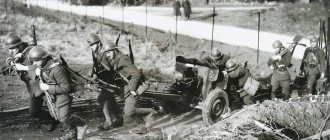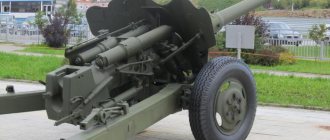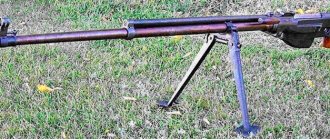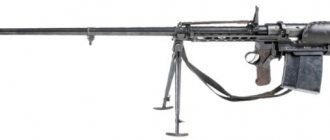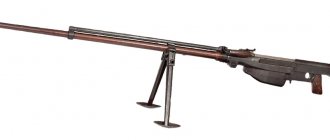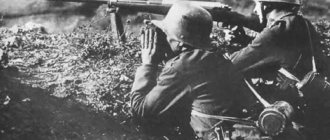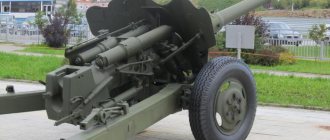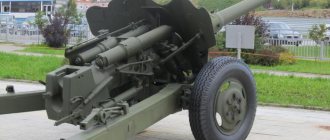Self-propelled anti-tank gun Sd.Kfz.164 "Nashorn"
The self-propelled gun was developed on the basis of the T-IV tank in 1942. The design widely used components of the T-III tank. For self-propelled installation, the tank chassis was rearranged: the fighting compartment is located at the rear, the power plant is located in the center of the hull, and the drive wheels, transmission and control compartment are located in the front part. The fighting compartment is an armored cabin open at the top, in which an 88-mm semi-automatic anti-tank gun with a length of 71 calibers is mounted on a machine. The gun fired at a speed of up to ten rounds per minute. High-explosive shells weighing 9.14 kg (with a firing range of 15.3 thousand meters), armor-piercing tracer, sub-caliber and cumulative shells could be used for firing. An armor-piercing tracer projectile from a distance of 1000 meters at an angle of 30 degrees to the normal is capable of penetrating 165 mm of armor, and a sub-caliber armor 193 mm thick. In this regard, the Nashorn installation was very dangerous for all enemy tanks in the event of battles over long distances. At the same time, in close combat the self-propelled gun lost its advantages due to insufficient armor. Serial production of the Nashorn self-propelled gun began in February 1943 and continued until the end of the war. About 500 self-propelled guns were produced. These self-propelled guns were part of heavy anti-tank destroyer units.
After the invasion of Soviet territory and the clash of German tank units with domestic KB and T-34 tanks, even the most optimistic German leaders realized that checkmate. Some of the previously invincible Panzerwaffe are largely inferior to the new Soviet-made tanks. Sometimes crudely constructed, but with excellent armor protection and powerful weapons, equipped with a V-2 diesel engine, Soviet armored vehicles “reigned” on the battlefields in 1941. When the last hopes of a blitzkrieg dissipated, German engineers had to get to work to bring prototype vehicles to mass production.
The development of new medium and heavy German tanks was delayed. In addition, it was necessary to put completely original designs into mass production. It was obvious that the Panther and Tiger tanks would not soon become truly widespread among the troops. The following technical advice suggested itself. The solution is to use tracked tank bases, which are widespread in the army, to install powerful artillery systems on them, capable of solving various tactical tasks. Thus, the troops received a whole family of various self-propelled artillery units, which belonged to the “class of field systems on a movable carriage.” This technique was characterized by placing guns in a semi-open cabin. The cabin armor protected the crew of the self-propelled gun only from shrapnel and bullets. According to this scheme, an anti-tank artillery mount was assembled and built, which later received the designation Sd.Kfz.164.
A unified self-propelled carriage (tracked base) of the new self-propelled artillery mount was developed in 1942. The base widely used standard components of the chassis of the PzKpfw III and IV tanks, which were widely used among the troops. This chassis, called "Geschutzwagen III/IV", was developed as a multi-purpose base for a whole family of self-propelled guns: anti-aircraft, anti-tank, artillery fire support units, etc. A feature of this design was the placement of the transmission and engine in the front part of the housing near the drive wheel. The fighting compartment was located towards the stern and was spacious. This made it possible to install a large-caliber artillery system in the wheelhouse, including a powerful anti-tank gun. But the anti-tank gun for the self-propelled gun had to be designed differently.
The first ideas for creating a self-propelled “tracked carrier” for Pak43 were expressed back on April 28. 1942 at a meeting in the arms department. Since the development of a completely original design would take a lot of time, during the discussion they put forward the idea of the possibility of developing some kind of intermediate model using units of mass-produced machines, which could be put into production at the beginning of 1943. The design contract was signed with. In turn, the company took advantage of Deutsche Eisenwerke’s developments to create a unified self-propelled carriage from PzKpfw III and IV chassis components. The demonstration of the prototype was scheduled for 10/20/1942.
A column of German armored vehicles is advancing along a clearing north of Lepel to support German units in the fight against partisans. The self-propelled gun “Rhino” (Nashorn) is moving behind the self-propelled gun based on the tractor. Behind it are two captured T-26 light tanks. The photo was taken at the end of April - beginning of May 1944
On October 2, 1942, at a meeting with the participation of Reich Minister of Armaments Speer and Hitler, they reviewed the finished design of the chassis from. This chassis in German documents received the traditionally long name “Zwischenloesung Selbstfahr-lafette”. Inspired by the rapid pace of design design, the Fuhrer began to make plans that by 05/12/1943 the industry would be able to produce 100 self-propelled guns monthly.
At the request of the Armaments Directorate, a hull was developed that had the same width as the PzKpfw III tank. Components and assemblies of the new self-propelled artillery mount, including drive wheels, differentials and transmission, were taken from the PzKpfw III. The engine with cooling system, radiators, muffler are from the average PzKpfw IV modification F. Support and support rollers, sloth track tracks were also borrowed from the “four”. The Maybach HL120TRM engine (12-cylinder, volume 11867 cm3, V-shaped, cylinder camber 60 degrees, four-stroke, carburetor, power at 3 thousand rpm 300 hp) was installed in the central part of the body. The “flooring” above the engine was strengthened as much as possible to place the artillery system near the center of gravity of the self-propelled gun.
However, due to the new purpose of the designed self-propelled gun, some units had to be designed anew. The design differences were described in the operating manual for the self-propelled artillery mount.
Air duct (“Kuehllufifuehrung”): to cool the engine, air is taken in through an intake window made in the left side and, bypassing the radiator and the engine itself located at an angle on the left side of the engine, is discharged through an opening made in the right side. Air is supplied by two fans located on the right side of the engine. The driver-mechanic of the self-propelled gun adjusted the air inlet opening.
An inertia starter (“Schwung-kraftanlasser”) installed to the left of the engine was connected to the shaft through a device (“Andrehklaue”) installed on the rear wall of the firewall. The inertia starter was intended to start the self-propelled gun engine in emergency situations. The inertial starter was powered by the muscular strength of the crew through a kickstarter located in the fighting compartment.
Fuel (leaded gasoline, octane number no less than 74) was contained in two tanks with a total capacity of 600 liters. The tanks were located under the bottom of the fighting compartment, and the filler necks of the tanks went inside in such a way that refueling could be carried out even under fire. In addition, special drain holes were made on the bottom of the body, through which fuel spilled in the event of an accident was “discharged” from the body of the self-propelled gun. Such devices were closed only when self-propelled artillery units forded water barriers.
The cooling device of the “Fuchs” (“Kuehlwas-serheizegerat Fauart Fuehs”) water heater was installed on the left side of the self-propelled gun hull.
The armor of the gun shield and wheelhouse was original. The thickness of the armor plates in the rear and sides was 10 millimeters, which gave the crew of the self-propelled gun protection from small fragments and non-armor-piercing bullets. Initially, the deckhouse sheets in the stern and along the sides were to be made of 20 mm, and in the frontal part from 50 mm SM-Stahl steel. However, to save weight, 30-mm hardened armor plates were used only in the frontal part of the self-propelled gun hull.
An 88-mm artillery system “Panzerjaegerkanone” 43/1, the barrel length of which was 71 calibers (88 cm Pak43/1 - L/71), was mounted in the self-propelled gun cabin with the upper part of the carriage. Structurally, this artillery system was identical to the towed 88-mm anti-tank missile system Rak43/41. However, the gun shield had a rounded shape, which ensured the rotation of the system inside the wheelhouse. The recuperator was installed above the barrel, and the knurling device was installed below. Counter-balancing cylinders were located on the sides of the gun. The guidance sector in the vertical plane is from -5 to +20 degrees. The pointing angle in the horizontal plane was 30 degrees (15 degrees in each direction).
In 1944-1945 These self-propelled anti-tank guns were equipped with 88-mm barrels from the Rak43 anti-tank gun on a cruciform carriage manufactured by . However, relatively few such samples were produced - 100 pieces.
Standard ammunition for 88 mm anti-tank guns Rak 43/1 and Rak 43: - Pz.Gr.Patr39/1 - armor-piercing tracer projectile; — Pz.Gr.Patr.39/43 — armor-piercing tracer projectile; - Spr.Gr. Flak 41 – fragmentation grenade (old style); — Spr.Gr.Patr.43 – fragmentation grenade; — Gr.39 HL – cumulative projectile; - Gr.39/43 HL - cumulative projectile.
Thus, in a short period of time, with the widespread use of serial tank units, a tank destroyer was created, for the first time in the German tank industry (together with the Ferdinand) equipped with a long-barreled (71 caliber) 88-mm artillery system. This vehicle could hit all heavy and medium Anglo-American and Soviet tanks from a distance of more than 2.5 thousand meters, however, due to the lightly armored and open wheelhouse, it was vulnerable during close combat, and even at medium distances, domestic KB and T-34s "left this design with very little chance of survival. Such a self-propelled gun was a kind of “ersatz”, which was capable of operating successfully only from ambush positions that were far away. As it turned out later, a truly effective tank destroyer must have powerful weapons, be well armored and have a low silhouette, which makes it difficult to defeat such a vehicle. This self-propelled gun did not have the last two advantages.
The production plan for the fourth financial year was approved on May 4, 1944. According to this document, the Sd.Kfz.164 self-propelled guns were completely exempt from assembly. Thus, the Stahlindustri corporation became the main contractor for the production of these self-propelled guns. The enterprises of this company were supposed to deliver 100 cars in 1944: in April - 30, in May - 30 and in June the last 40.
This program was adjusted on June 14, 1944: in April 1944 - 14 self-propelled guns Sd.Kfz.l64, in May - 24, in June - 5, in July - 30, in August - 30 and in September - 29. Total 130 vehicles were to be produced.
88-mm heavy anti-tank self-propelled gun "Hornisse" (Hornet) with its own name "Puma" (Puma). Belongs to the 519th Tank Destroyer Division. Belarus, Vitebsk region
It should be noted that in parallel with production, an epic was unfolding to rename this self-propelled gun, transforming the Sd.Kfz.164 from “Hornisse” (“Hornet”) to “Nashorn” (“Rhinoceros”).
For the first time, the idea to rename the Sd.Kfz.l64 came to Hitler on November 29, 1943. The new name of the self-propelled gun was already mentioned on February 1, 1944 in the documents of the OKW (Wehrmacht High Command), and on February 27 - in the orders of the OKH (Commander in Chief of the Ground Forces).
However, in the official correspondence dated in the summer of 1944, the old name is still present - “Hornisse” (“Hornet”), and only starting in September 1944, the new – most specific – designation “Nashorn” was introduced into the document flow.
The motivation for such a renaming remains unclear. Probably "Rhinoceros" in German sounds more menacing than "Hornet"; Probably, the pedantic Germans wanted to identify the entire “subclass” of new types of self-propelled guns (tank-killing self-propelled guns) and tanks with mammals (although in this case there are exceptions - the Pz IV/70 fighter tanks were never named). Perhaps there is a third option: the Hornisse self-propelled artillery mounts were supposed to be equipped with a Pak43 cannon of 88 mm caliber, but in practice this never happened. But in any case, the “reincarnation” was completed and in September 1944, the “new-old” self-propelled guns appeared in the Wehrmacht - Sd.Kfz.164 “Nashorn” (“Rhinoceros”).
The serial production of self-propelled guns of this type was delayed (in total it was planned to produce 500 Hornisse and Nashorn self-propelled guns). But since the Anglo-American aviation, following the principles of General Douhet, the theorist of air strikes, continued to methodically destroy German arms factories according to the next program for the production of armored vehicles, dated January 30, 1945 it was prescribed that 9 vehicles should be delivered in January 1945, and the last two in February.
On March 14, 1945, at a meeting with the Inspector General of Tank Forces, production issues were discussed, including the difficulty of starting mass production of the new 88-mm self-propelled guns "Waffentraeger" and 150-mm self-propelled guns for artillery support "Hummel" ("Bumblebee"), of the same type with Nashorn on a tracked base.
At this meeting, the cessation of Nashorn production was documented. In addition, the German industry tried to start large-scale production of its “successor” Sd.Kfz.164 - the Waffentraeger tracked transporter equipped with an 88-mm Pak43 artillery system.
The 560th heavy tank destroyer division took part in the Forty-second Army Corps in Operation Citadel and did not permanently lose a single self-propelled gun. The division's batteries supported the 282nd, 161st and 39th Wehrmacht infantry divisions. However, already in August, the 560th separate division lost 14 vehicles, of which several self-propelled guns went to the Soviet troops as trophies. Five vehicles arrived to make up for losses on September 3, five on October 31, and the same number on November 28. The last replenishment of the equipment - four self-propelled guns - took place on 02/03/1944.
According to the headquarters of the 560th division, by the end of 1943, self-propelled gun crews destroyed 251 tanks during combat operations.
On February 4, 1944, the division received an order to quickly retreat to the rear, from where it was to be transferred to Milau to be re-equipped with new Jagdpanther self-propelled guns. According to the report dated 01.03. 1944 combat losses of the unit during its operation as part of the Fifty-seventh Tank Corps amounted to 16 Hornisse self-propelled guns. At the end of April, the 560th division was completely re-equipped with Jagdpanther tank destroyers.
From 07/11/1943 to 07/27/1943, the 521st battery of the 655th tank destroyer division took part in defensive battles east of Orel. On August 27, 1943, the unit’s combat experience was summarized in a special unit. report.
At the beginning of hostilities, the battery had 188 soldiers, 28 non-commissioned officers, 4 officers, 13 heavy Sd.Kfz.l64 Hornisse self-propelled guns, 3 Flak-Vierling anti-aircraft guns. This unit was part of the Thirty-fourth Army Corps of Army Group Center. The 521st battery took part in combat operations from July 11 to July 27.
In two weeks of fighting, self-propelled guns destroyed one KV-2 tank, 1 American-made M3 General Lee, 1 MLRS on a tracked chassis, 1 T-60 tank, 3 trucks, 5 T-70 tanks, 19 KB tanks, 30 T- tanks 34, one MKII Matilda II tank was disabled.
German losses mat. The units consisted of one Kfz.l and "Maultir", two tank destroyers "Hornisse". Killed - one gunner and one vehicle commander; missing - one vehicle commander; wounded - 20 soldiers, six non-commissioned officers and two officers.
For Hornisse self-propelled guns in battle, the following tactical technique was most effective: Sd.Kfz.164 self-propelled artillery mounts should operate from camouflaged positions, repelling the advance of enemy armored vehicles.
A good example is the battle carried out on July 13, 1943 by a platoon of self-propelled guns of the 521st battery. Then the Hornisse platoon knocked out four T-34 and 12 KB tanks from a well-camouflaged position. The platoon did not suffer any losses even though the Soviet troops attacked with air support.
When stationary tanks were used as artillery firing points, success could only be achieved after careful reconnaissance on foot and only with surprise fire from a short distance, which the Hornisse self-propelled guns approached covertly. The self-propelled gun, after a high-speed “fire attack,” retreated again to cover.
An example of such actions was the battery battle carried out on July 23. During the extremely dangerous advance of enemy infantry and tanks into the rear and flank of the grenadier regiment, the battery moved into a hollow and, after reconnaissance on foot, took up firing positions. From the new position, one T-34 and one KB tank were each knocked out. Thus, the Soviet troops were stopped for a while.
In total, in the period from 1943 to 1945. out of 500 vehicles planned for construction, according to German data, 494 vehicles were manufactured. We can say that the Nashorn production program has almost been completed. By February 1, 1945, the troops still had 141 vehicles of this type, but by April 10, only 85 Sd.Kfz.164 “Nashorn” self-propelled guns remained.
Tactical and technical characteristics of the Hornisse/Nashorn (Hornet/Rhinoceros) self-propelled artillery mount:
Combat weight - 24 tons; Crew - 5 people (commander, radio operator, loader, gunner, driver); Overall dimensions: - total length - 8440 mm; - length excluding barrel - 6200 mm; — width — 2950 mm; – height – 2940 mm; — height of the firing line – 2360 mm; — track base – 2520 mm; -track surface length – 3520 mm; — ground clearance – 400 mm; Specific pressure per pound - 0.85 kg/cm2; Cruising range: - on a country road - 130 km; — on the highway – 260 km; Speed: — maximum — 40 km/h; — cruising on the highway – 25 km/h; — on a country road – from 15 to 28 km/h; Obstacles to be overcome: - slope - 30 degrees; - trench width - 2.2 m; — wall height – 0.6 m; — ford depth – 1 m; Engine – “Maybach” HL120TRM, power at 2.6 thousand rpm 265 hp; Fuel capacity – 600 l; Transmission (early / remaining): - forward speeds - 10/6; — back – 1/1; Control – differentials; Chassis (on one side): – drive wheels located at the front; — 8 double rubber-coated rollers assembled into four carts with a diameter of 470 mm; Suspension of road wheels – leaf springs; Track width – 400 mm; Number of tracks – 104 in a caterpillar; Communication: - radio station Fu.Spg.Ger for linear vehicles. "f" or FuG5; - for self-propelled guns of battery commanders - FuG5 and FuG8; - intercom; Reservations: - gun shield - 10 mm (from May 1943 - 15 mm); — cutting edge – 15 mm; — deckhouse sides – 10 mm; -6 body mouth – 20 mm; — body forehead – 30 mm; — body roof – 10 mm; — hull rear – 20 mm; — body bottom – 15 mm; Armament: - 88-mm cannon Pak43/1 (L/71); MG-34 machine gun, 7.92 mm caliber; two MP-40 9mm submachine guns;
Ammunition: — rounds — 40 pcs.; — cartridges of 7.92 mm caliber – 600 pcs.; — 9 mm caliber cartridges – 384 pcs.
German anti-tank self-propelled gun "Rhino" (Panzerjäger "Nashorn", Sd.Kfz. 164). The photo was taken on the Soviet-German front in early 1944
A Canadian soldier on a captured German Nashorn self-propelled gun. Summer 1944
Soldiers of the Westminster Regiment of the 5th Canadian Tank Brigade (Westminster Regiment, 5th Canadian Armored Brigade) in the combat compartment of the German self-propelled gun "Nashorn" (Sd.Kfz. 164 "Nashorn"), hit by a PIAT anti-tank grenade launcher on the street of the Italian village of Pontecorvo ( Pontecorvo)
Sending self-propelled guns Sd.Kfz.164 to the front. It is clear that these are modernized self-propelled guns: the barrel-shaped muffler is no longer there, but the gun latches are of an old design. Most likely these are the vehicles with which the 650 heavy tank destroyer was equipped. May 1943.
Camouflaged self-propelled gun Sd.Kfz.164 "Hornisse" in its original combat position. Most likely this is Italy, 525th heavy tank destroyer division, 1944
After installing the SflZFIa sight, the gunner positions the cylinder of the ZE 37 sighting system. Italy, 525th Tank Destroyer Division, summer 1944
Self-propelled gun "Hornisse" of an early type in anticipation of an attack by Soviet tanks. The bracket is folded, there are marks on the barrel about 9 or 10 destroyed enemy tanks. Army Group Center, 655th Tank Destroyer Division, summer 1943.
A photo of one of the early Hornisse self-propelled guns
Self-propelled gun Sd.Kfz.164 "Hornisse" of an early type. In the opening of the wheelhouse, the steering wheel for the rear lock of the 8V-mm cannon is clearly visible; at the rear of the hull there is a barrel-shaped muffler. The armored antenna input is located in the rear upper right corner of the cabin - such antenna inputs were only available on command vehicles equipped with the FuG 8 radio station. Summer 1943
Sd.Kfz.164 vehicles of the first series, assembled in February - March 1943 and delivered to the 560th separate heavy tank destroyer division. The characteristic differences of the self-propelled guns of early construction are visible: drive wheels from the Pz.Kpfw.m Ausf.H, two front headlights, an external gun barrel holder (early type), a barrel-shaped muffler, FOOT FOOTPRINTS, tool boxes, fastening of the banner sections. Spring 1943
Links
- Wikimedia Commons has media related to Nashorn
- Grosstraktor
- PzKpfw III
- PzKpfw III/IV
- PzKpfw IV
- VK3001(H)
- VK3001(P)
- PzKpfw V "Panther"
- Panther II
- E-50
[/td]
Medium tanks Heavy tanks - Neubaufahrzeug
- DWI/II
- VK4502(P)
- VK3601(H)
- VK6501(H)
- "Tiger" (P)
- PzKpfw VIE "Tiger"
- PzKpfw VIB "Tiger II"
- E-75
Super heavy tanks - PzKpfw VII "Lion"
- PzKpfw VIII "Maus"
- E-100
- "Ratte"
- "Monster"
- Panzer IX/X
Tank destroyers - Jagdpanzer IV
- Jagdpanzer 38(t) "Hetzer"
- "Jagdpanther"
- "Ferdinand"
- "Jagdtiger"
- E-10
- E-25
Self-propelled howitzers - Sturmpanzer I
- Sturmpanzer II
- Sd.Kfz.135/1
- "Vespe"
- "Grille"
- "Hummel"
- Geschutzwagen Panther
- Gerät 809
RZSO - Panzerwerfer 42
- Wurfrahmen 40
ZSU - Kfz.4
- Sd.Kfz.10/4
- Sd.Kfz.6/2
- Flakpanzer I
- Flakpanzer 38(t)
- "Mobelvagen"
- "Wirbelwind"
- "Ostwind"
- "Kugelblitz"
- Flakpanzer V
* - produced only for export; italics Promising, experimental, or samples that did not go into mass production were identified
